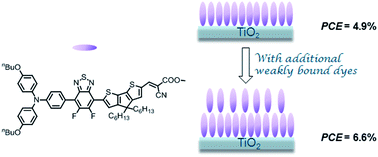Deposition of loosely bound organic D–A–π–A′ dyes on sensitized TiO2 film: a possible strategy to suppress charge recombination and enhance power conversion efficiency in dye-sensitized solar cells†
Abstract
A D–A–π–A′ dye (coded as AR-II-13) – composed of a triarylamine donor, a difluorobenzothiadiazole internal acceptor and a cyanoacrylic acid anchoring acceptor – has been successfully synthesized via sequential C–H direct arylation, and used as sensitizer in dye-sensitized solar cells (DSSCs). The butoxy group at the donor side and the hexyl group on di-substituted cyclopenta[1,2-b:5,4-b′]dithiophene (CPDT) bridge are incorporated to decrease dye aggregation and offer physical insulation between electrolyte oxidant and TiO2 films. It is demonstrated that the open circuit voltage (VOC), short circuit current (JSC) and power conversion efficiency (PCE) are remarkably enhanced relative to a conventionally fabricated cell by deposition of additional dye on the sensitized TiO2 films. The impact of dye bath solvent on dye aggregation was observed to be minimal and the enhancement of solar cell performance was exclusively ascribed to the loosely bound dye moieties providing physical insulation on TiO2 films from I3− and retarding charge recombination between electrons in the TiO2 film and the electrolyte, as confirmed by electrochemical impedance measurements. Furthermore, the dipole interaction between the TiO2 surface and loosely bound dye may play a synergetic role in enhancing the photovoltaic performance of the resulting devices.


 Please wait while we load your content...
Please wait while we load your content...